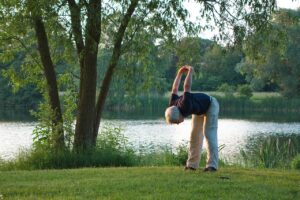
Are you a senior looking to shed some extra pounds and improve your overall health? Look no further! This article will introduce you to an effective exercise program specifically designed for seniors over the age of 60 to help you reach your weight loss goals. With a focus on low-impact exercises that are gentle on the joints and tailored to meet the unique needs of older individuals, this program will help you increase your strength, flexibility, and endurance while burning calories and shedding unwanted weight.
Say goodbye to fad diets and restrictive meal plans – with this exercise program, you’ll be well on your way to a healthier, happier you in no time! Are you a senior looking to lose weight but unsure where to start your fitness journey? In this article, we will guide you through the steps of creating an effective exercise program tailored specifically for seniors over 60 who are looking to shed those extra pounds.
Why Exercise is Important for Seniors
Let’s dive into why implementing an exercise routine is crucial for seniors looking to lose weight. Exercise not only helps with weight loss but also improves overall health and quality of life. It can boost your metabolism, strengthen muscles, improve heart health, increase flexibility, and enhance mood. By engaging in regular physical activity, you can maintain a healthy weight and reduce the risk of chronic diseases such as diabetes, heart disease, and osteoporosis.
Why Weight Loss is Important for Seniors
Losing weight as a senior is beneficial because it can help reduce the risk of developing obesity-related diseases. Excess weight puts unnecessary strain on joints and organs, leading to various health issues. Shedding extra pounds can also improve mobility, increase energy levels, and boost self-confidence. By maintaining a healthy weight, seniors can enjoy a better quality of life, increased longevity, and decreased reliance on medication or medical interventions.

Assessing Your Current Fitness Level
Before starting any exercise program, it is essential to assess your current fitness level. This will help you determine your baseline, set realistic goals, and prevent injury. Here are a few assessments you can perform to evaluate your physical capabilities:
1. Cardiovascular Fitness
To assess your cardiovascular fitness, you can do a simple walking test. Measure the distance you can walk in six minutes and record your heart rate before and after the test. This will give you an indication of your aerobic capacity and overall cardiovascular health.
2. Muscular Strength
Testing your muscular strength is important, especially as we age. Simple exercises like push-ups, squats, or bicep curls can help assess your upper and lower body strength. Perform as many repetitions as you can with good form and record your results.
3. Flexibility
Flexibility is crucial for seniors to maintain mobility and prevent injuries. Perform a sit-and-reach test to measure your flexibility. Sit on the floor with legs extended and bend forward to reach towards your toes. Measure how far you can reach and track your progress over time.
Designing Your Exercise Program
Now that you have assessed your fitness level, it’s time to design a personalized exercise program tailored to your needs and goals. Your exercise program should include a combination of cardiovascular, strength training, flexibility, and balance exercises to ensure overall fitness and weight loss.
Cardiovascular Exercise
Cardiovascular exercise is essential for burning calories, improving heart health, and boosting metabolism. Choose activities like walking, cycling, swimming, dancing, or aerobics to get your heart rate up and increase endurance. Aim for at least 150 minutes of moderate-intensity cardio per week, spread throughout the week.
Strength Training
Strength training is crucial for maintaining muscle mass, increasing metabolism, and enhancing overall strength. Focus on exercises that target major muscle groups such as the legs, arms, back, and core. Use resistance bands, dumbbells, or body weight exercises to build muscle and improve functional strength. Aim for two to three strength training sessions per week, with a day of rest in between.
Flexibility and Balance Exercises
Flexibility and balance exercises are important for seniors to prevent falls, improve mobility, and maintain joint health. Incorporate activities like yoga, tai chi, or stretching exercises to increase flexibility and enhance balance. Perform these exercises daily or at least three to four times per week to see improvement in flexibility and balance.
Sample Exercise Program
To give you an idea of what a well-rounded exercise program for seniors to lose weight might look like, here is a sample weekly schedule:
| Day | Activity | Duration |
|---|---|---|
| Monday | Walking | 30 minutes |
| Tuesday | Strength Training | 20 minutes |
| Wednesday | Yoga or Stretching | 15 minutes |
| Thursday | Swimming | 30 minutes |
| Friday | Aerobics | 20 minutes |
| Saturday | Rest Day | |
| Sunday | Balance Exercises | 15 minutes |
Feel free to customize this sample program based on your fitness level, preferences, and availability. Remember to listen to your body and make adjustments as needed to ensure a safe and enjoyable workout experience.

Tips for Success
Embarking on a weight loss journey can be challenging, but with the right approach and mindset, you can achieve your goals. Here are some tips to help you stay motivated and committed to your exercise program:
1. Set Realistic Goals
Set achievable and realistic goals for your weight loss journey. Start with small changes and gradually increase the intensity or duration of your workouts. Celebrate your accomplishments along the way to stay motivated and on track.
2. Stay Consistent
Consistency is key when it comes to losing weight and improving fitness. Make exercise a priority in your daily routine and set aside dedicated time for physical activity. Aim to be active most days of the week to see progress and results.
3. Listen to Your Body
Pay attention to how your body feels during and after exercise. If you experience pain, dizziness, or shortness of breath, stop the activity immediately and seek medical advice if needed. Adjust your workout intensity or duration as needed to prevent injury and promote recovery.
4. Stay Hydrated and Eat Well
Proper hydration and nutrition are crucial for overall health and weight loss. Drink plenty of water throughout the day to stay hydrated, especially during and after exercise. Eat a balanced diet rich in fruits, vegetables, whole grains, lean protein, and healthy fats to support your weight loss goals and fuel your workouts.
5. Monitor Your Progress
Keep track of your workouts, progress, and achievements to stay motivated and accountable. Use a fitness journal, app, or fitness tracker to monitor your exercise frequency, duration, intensity, and weight loss. Seeing improvements over time will help you stay focused and motivated to continue on your fitness journey.
Conclusion
In conclusion, designing an effective exercise program tailored to seniors over 60 can help you achieve your weight loss goals, improve overall health, and enhance your quality of life. By incorporating a balanced combination of cardiovascular, strength training, flexibility, and balance exercises into your routine, you can boost metabolism, burn calories, increase muscle mass, improve flexibility, and maintain a healthy weight. Remember to assess your fitness level, set realistic goals, stay consistent, listen to your body, eat well, and monitor your progress to ensure long-term success on your weight loss journey. With dedication, commitment, and the right mindset, you can achieve your fitness goals and enjoy a healthier, more active lifestyle as a senior. Start today and take the first step towards a happier and healthier you!





